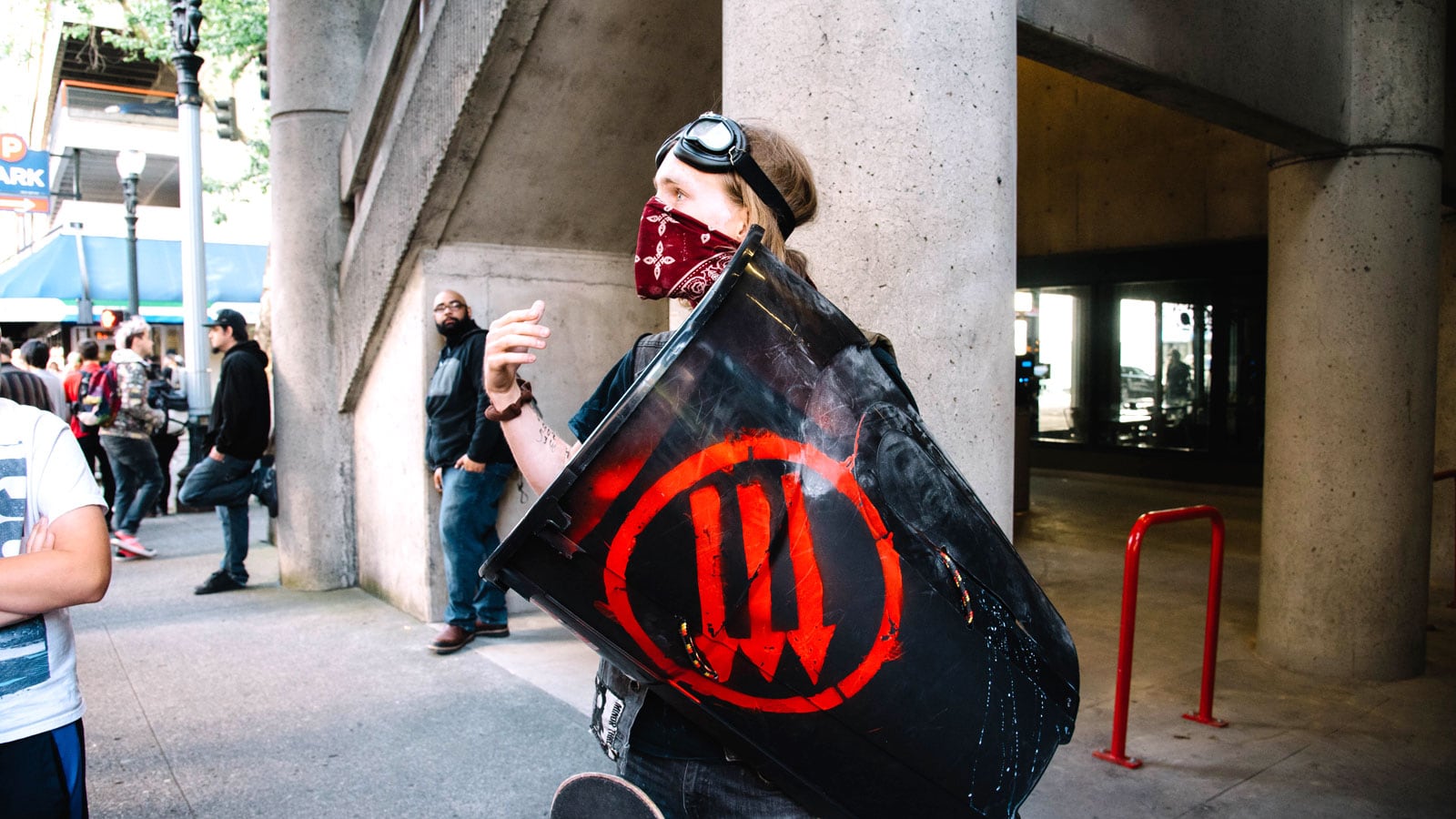For the past week, Portlanders anticipated the impending clash between traveling right-wing agitators and masked lefty activists with concern.
The timing of an "alt-right" rally in downtown, nine days after the racially charged murder of two men on a MAX train, had many locals wondering if Portland would become the latest U.S. city to host bloody political street brawls.
But June 4, the confrontation ended with a whimper—and a few bangs.
A crowd of more than 1,000 left-leaning demonstrators arrived downtown first, and gradually surrounded the roughly 250 alt-right protesters who gathered wearing helmets and other DIY riot gear in Terry Schrunk Plaza.

For hours, left-wing protesters harangued the visitors, calling them Nazis. The right-wing protesters taunted back. But neither side made much effort to breach the ring of police and Homeland Security officers who formed a human wall around the plaza.
The most lasting grievance from the afternoon was a familiar complaint: that Portland police cracked down too aggressively on local antifascists and anarchists.
Police used stun grenades and rubber bullets to drive masked antifa protesters from Chapman Square, and made 14 arrests.
"This was an entire crowd of peaceful protesters that had literally done nothing wrong," wrote protest organizer Gregory McKelvey in a widely shared June 5 web post. "Their only crime was standing up to white supremacy in a peaceful way."
The Portland Police Bureau said officers acted in response to people in the crowd throwing bricks and large firecrackers at riot police. Those allegations could not be independently confirmed, but reporters did see protesters throw red-stained, apparently bloody tampons at officers while chanting, "All cops are bastards!"

In a Trump-despising town, the police tactics felt heavy-handed to some civil rights activists and raised questions about law enforcement punishing many people for the bad behavior of a few.
But those tactics may also have averted a street war—by moving the two most extreme political factions away from each other long enough for alt-right leaders to quietly leave town.

As police chased left-wing activists, detaining some in the middle of downtown streets, alt-right celebrities like California's Kyle Chapman gave speeches praising nationalism and religion. ("Countries like Russia, which have continued to embrace God, have stayed strong," Chapman said. "Secular nations that have abandoned God are facing terroristic threats.") They then wandered the streets, looking for the garage where they had parked their cars.
Police spokesman Sgt. Pete Simpson says the bureau's goal was keeping the antifa and alt-right apart.
"I've seen the narrative: 'Police are protecting Nazis,'" says Simpson. "That's baloney. The Constitution allows people to say really nasty things about each other, and to each other. Our job is to keep everybody separate and everybody safe. Everybody gets to go home."
But two days after the smoke from the stun grenades cleared, several questions linger.

Why did police officers force antifascist protesters out of Chapman Square?
For much of the day, Portland police and other law-enforcement agencies created a perimeter around Terry Schrunk Plaza and held it. Then they decided, at roughly 3:30 pm, to change that policy and force antifascist and anarchist protesters out of the park directly north of the federal plaza.
Simpson says police decided to press into Chapman in part because people were throwing bricks and large fireworks.
He also tells WW that police believed antifa protesters were planning to charge the police lines and brawl with the alt-right crowd. "There were unconfirmed reports that people were plotting to charge across to Schrunk Plaza around the time of the [alt-right] speakers," Simpson says. "The decision was made to widen that gap between Schrunk Plaza and the crowd in Chapman."
In the minutes that followed, reporters observed riot-squad officers repeatedly deploy rubber bullets at unarmed protesters—including a group of five antifa activists huddling behind a "Mourn the Dead" banner.
Cops firing unprovoked rubber bullets at kids holding sign that says "mourn the dead" pic.twitter.com/3H5vakYGUl
— Karina Brown (@karinapdx) June 4, 2017
The use of force against the crowd in Chapman has sparked claims that police were picking ideological sides. That argument is undermined by observations and evidence of thrown objects. On June 6, the American Civil Liberties Union of Oregon offered a more sober criticism—saying that the police response was out of proportion with the alleged crimes.
"While we understand that policing is no easy task, the pattern in Portland is clear," ACLU legal director Mat dos Santos writes. "After a rock, stick, or liquid is thrown, Portland protests regularly devolve into the indiscriminate use of force and crowd control weapons.
"Our democracy is not so fragile that a rock thrown turns off the First Amendment for everyone in our city," dos Santos writes. "This kind of disproportionate response is dangerous to our democracy and our lives."

Why did police detain people in the street and photograph their IDs? And why doesn't the police chief know about it?
In an interview with OPB's Think Out Loud on June 6, Police Chief Mike Marshman misrepresented a high-profile moment of Sunday's law-enforcement response to the protest.
At the 11-minute mark of the interview, Marshman incorrectly stated that police officers had not corralled people and taken photos of their ID's before releasing them.
"You know I actually have not heard that at all frankly. We did have other partner agencies there…," Marshman told OPB. "I have not heard of anyone being detained and their IDs' pictures being taken."
Marshman appeared completely unfamiliar with this incident. Yet there's no debate the incident happened. It occurred around 4:30 pm, when police surrounded a traveling group of protesters on four sides and detained about 200 of them in the street.
Police confiscated a pile of potential weapons—mostly blunt objects and some fireworks—arrested a handful of people and let the rest leave the corral one by one, while scanning their IDs on the way out.

The event was widely documented, in part because several of the people detained were working journalists. In a tally kept by independent video journalist Mike Bivins on Twitter, nine journalists, including Bivins, who was covering the protest for WW, were among those corralled.
When Think Out Loud host Dave Miller pressed Marshman on whether he's sure that Portland Police Bureau officers weren't involved, the chief went further, and implied photographing IDs was a violation of bureau policy. "Not to my knowledge," he said, "because that's not our practice. We don't do that."
It's something of a mystery why Marshman would be unfamiliar with the incident or the bureau's past practices.
PPB spokesman Pete Simpson tells WW he immediately tried to correct the factual inaccuracy and to correct the impression that police would not be allowed to take photographs of IDs.

"Chief Marshman had not been briefed on that aspect of the event," Simpson tells WW. "I feverishly wrote a note for him but it was too late to get on air. Sent a note to Dave Miller to correct the record.
"The photos were used to compare against other media showing the criminal conduct of some people in Chapman Square. Most photos will probably not yield any results and will be disposed of. Several people were spotted discarding their clothing and weapons before being checked by police."
Simpson added that officers are allowed to take photos as part of investigation, as they were on Sunday, and that the photos would not be used to create any kind of database. "There was no watch list created. There was no database created. That's not the intended purpose," he says.
The ACLU tonight decried the detaining of protesters and reporters—and says it was illegal.
"Photographing the face and ID of every person detained is a likely violation of the Oregon state law prohibiting the collection and retention of personal information based on political beliefs."

Why did a right-wing militia member help arrest a counterprotester?
On June 5, social media filled with images taken by an OPB photographer of a member of the right-wing militia called the Oath Keepers kneeling in the Portland sidewalk, helping Homeland Security officers arrest a left-wing counterprotester who had tried to rush the federal plaza.
I forgot I caught this image of an oathkeeper (serving as private security for the pro-Trump crowd yesterday) help… https://t.co/f1jAgk1GNx pic.twitter.com/2RRC4xz7Iy
— Bryan M. Vance (@BryanMVance) June 5, 2017
The arrival of the Oath Keepers in Portland was in itself controversial.
The Guardian broke several stories last week about the Oath Keepers, revealing that the Multnomah County Republican Party was considering using the militia as security, and that Oath Keepers would attend the alt-right rally as a private security force.
The Center on Extremism at the Anti-Defamation League warned the Republicans that the Oath Keepers have performed such security work for insurrectionist and white supremacist fringe groups.
"We think it is important for you to know that the Oath Keepers and Three Percenters are not a benign 'security force,'" The ADL wrote. "They are, in our judgment, militia-style, anti-government extremist groups."
So the images of an Oath Keeper acting as an assistant to federal agents in Portland during a right-wing rally were especially unsettling.
In his radio interview today, Marshman—whose police force did not make the arrest—acknowledged it was a bad look. "Especially at protest scenes when there are a lot of officers there anyway and emotions are running high," he said, "we definitely encourage people not to get involved, to just watch at best."
This afternoon, The Portland Mercury first reported that the U.S. Attorney's Office is reviewing the arrest to see if federal policies were violated.
It wasn't the only time that Oath Keeper—whose name has not been reported—was spotted working among Homeland Security officers. He also shows up at the end of this video clip, assisting with crowd control.


